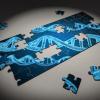Simulating earthquakes for a safer future
Life in New Zealand is shaped by earthquakes. Just as the land is sculpted by the slow grind of tectonic plates, raising alpines and flooding land, the residents of New Zealand and our cities are similarly carved.
Dr Brendon Bradley is an earthquake engineer and Deputy-Director of QuakeCoRE, a research centre for earthquake resilience. Brendon is using NeSI supercomputers to improve earthquake simulations and build better structures.
“We simulate how earthquakes cause waves that propagate through the earth. We model how they shake buildings, bridges and other sorts of infrastructure. We can use that computation to determine the earthquake’s physical impact,” Brendon said.
Brendon’s team are working on building more accurate earthquake simulations. At the moment, earthquake damage is predicted by mapping past tremors and building a statistical model. But these models often fail to account for microzones – areas where the earth may contain different types of soil and rock.
“We started on this after the 2010 Cantebury earthquake. There was over $40 billion dollars of damage, which was 20 per cent of our yearly GDP,” he said.
The Canterbury earthquake’s aftershock also caused the Christchurch earthquake in 2011. Combined, these earthquakes killed over 185 people and injured thousands more. It was a devastating moment in New Zealand’s history.
The Canterbury and Christchurch earthquakes began an effort to better understand why some buildings survived while others didn’t, leading to Brendon’s research into microzonation – mapping microzones of varied geology.
“Looking back on the recordings of shaking from 2011, it became clear there was microzonation. Certain areas had higher amounts of shaking, leading to more damage.”
“Now we’re modelling the specific geology of the earth at each location we care about. Say it’s Wellington, Auckland or Christchurch, we model the geometry of the fault beneath those places – the angle and bend of that fault and how it moves.”
With this new modelling, Brendon’s research can be used to zone different areas by earthquake damage risk. Engineers can design sturdier buildings in those zones to withstand the greater amount of shaking, leading to less damage.
This refined form of earthquake simulation also means a high demand for supercomputing power. The geology of the earth is turned into a 3D model and tremors are simulated within it. How those tremors interact with different soil and rock types shows how buildings built atop them will shake.
“We use millions of core hours every year from NeSI. Our research team actually includes former NeSI software developers, so we push the bleeding-edge boundaries more. We challenge NeSI with new things and their team gives us the familiarity with hardware and storage systems we don’t have.”
Brendon’s team use both the NeSI Mahuika and Maui supercomputers. One recent example of their simulation takes into account Wellington’s unique earth properties. Wellington is built upon a rocky slope that flattens out into Wellington harbour. As the land flattens to meet the sea, the rocky earth gives way to deeper soil. The soft, shifting soil causes more shaking during earthquakes and puts the buildings built upon it at greater risk of damage.
“The November 2016 Kaikoura earthquake caused a lot of damage to multi-storied buildings in Wellington. Some parts of the CBD were much more damaged than others, where the deep soil had caused more shaking.”
The simulations are already leading to surprising insights into how New Zealand’s infrastructure reacts to the shaking ground beneath it. Brendon is optimistic about how far this technology can be applied to preventing destruction in the country’s future.
“The technology is already better in some ways, but the rate of improvement is really the great thing. We’re bringing in engineers to talk about how they can use these scientific results in building and construction.”
The future of Brendon’s work will require even more work with NeSI. Hopefully one day, research like Brendon’s will help buildings better weather the devastating earthquakes common to New Zealand, saving the lives of many.
---------------------
Do you have an example of how NeSI platforms have supported your work? We’re always looking for projects to feature as a case study. Get in touch by emailing support@nesi.org.nz.






